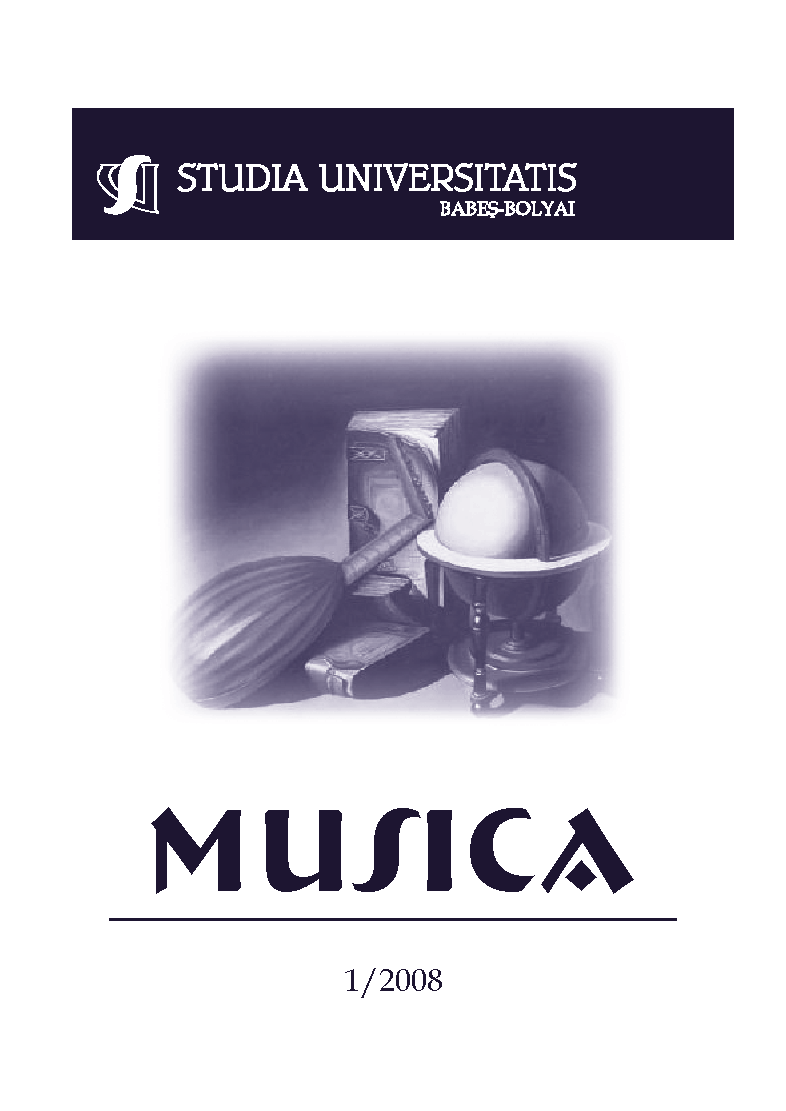TOWARDS A THEORIZING OF THE MANNERIST STYLE IN MUSIC
Abstract
The mannerist style could be evaluated as a historical period or as an aesthetic constant in art history. In contemporary musicology, we already have the frame of a mannerist period that might correspond, in music, to what was happening at the time in fine arts and in literature (in the transition from Hochrenaissance to Hochbarock), and the composer unanimously considered mannerist - in such a context - remains Gesualdo da Venosa. But mannerism could be seen also as a constant infiltrated within other styles and highlighting its characteristic manifestations, according to each case. Arguments could outline a mannerist tradition that connects musical guidemarks which are remote in time: representatives of the Renaissance with Bach, with Schumann and other romantics, with Berg and other moderns, with Berio and other postmoderns. This paper sketches some concepts, symbols, procedures that could be related with the aesthetic constant of mannerism in music: the magic letter, Ars combinatoria, the magic square, the magic number, the ludic element, musical quotation, labyrinth, mirror, masque.
References
1. General Bibliography:
***, Between Antiquity and Renaissance. The Thinking of the Middle Ages, Edit. Minerva, B.P.T., Bucharest, 1984.
***, Mannerism, Art and Theory. G.P. Lomazzo – The Idea of the Painting Temple; F. Zuccaro – The Idea of Painters, Sculptors and Architects, Ed. Meridiane, Bucharest, 1982.
***, The Renaissance and Mannerism. Studies in Western Art. Acts of the 12th International Congress of the History of Art, vol. II, Princeton University Press, 1963.
***, Zauber der Medusa. Europäische Manierismen, Ed. Werner Hoffman, Löcker Verlag, Wiener Festwochen, 1987.
Allard, G., Lefort, P., La Masque. Collection "Que sais-je?", Presses Universitaires de France, Paris,1984.
Balotă, N., Explorations in the Universe of Mannerism, In: "Euphorion", E.P.L., Bucharest, 1969.
Baltrusaitis, J., Anamorfosis or the Artificial Magic of Miraculous Effects, Edit.Meridiane, Bucharest, 1975.
Baltrusaitis, J., The Mirror, Edit.Meridiane, Bucharest, 1981.
Battisti, E., Antirenaissance, Edit.Meridiane, Bucharest 1982.
Baumgart, F., Renaissance und Kunst des Manierismus, In: DuMont Dokumente, Verlag M.DuMont Schauberg, Köln, 1963.
Carcopino, J., Etudes d'histoire chrétienne. Le christianisme secret du carré magique. Edit. Albin Michel, Paris, 1953.
Călinescu, M., Classic - Romantic - Baroque - Mannerist, In: Clasicism, Baroc, Romantism, Ed. Dacia, Cluj, 1971.
Curtius, E. R., Europäische Literatur und lateinisches Mittelalter, Edit.Univers, Bucharest, 1970.
Ghyka, M., Aestetics and Art Theory, Ed. Ştiinţificã şi Enciclopedicã, Bucharest, 1981.
Goethe, J. W., Faust, Edit.Univers, Bucharest, 1982.
Hauser, A., Der Ursprung der modernen Kunst und Literatur. Die Entwicklung des Manierismus seit der Krise der Renaissance, München, 1964.
Hocke, G. R., Die Welt als Labyrinth, Rowohlt, Hamburg,1964.
Hocke, G. R., Mannerism in Literature, Edit.Univers, Bucharest, 1977.
Huizinga, J., Homo ludens, Edit.Univers, Bucharest, 1977.
Kernbach, V., Dictionary of General Mythology, Ed. Albatros, Bucharest, 1983.
Lanners, E., Le livre des ilusions, Acropole, 1990.
Mann, Th., Doctor Faustus, Editura Muzicală, Bucharest, 1975.
Marino, A., Baroque. Classic. Clasicissism. Classical. Classic and modern. In: Clasicism, Baroc, Romantism, Ed. Dacia, Cluj,1971.
Papu, E., About Styles, Edit.Eminescu, Bucharest, 1986.
Roschitz, K., Formen des Manierismus in literarische Zeitschriften des 1.Hälfte des XX.Jahrhunderts. Doctoral Thesis at the Vienna University, 1966.
Shearman, J., Mannerism, Ed. Meridiane, Bucharest, 1983.
Vianu, T., Mannerism and Asianism, In: Studies for Universal and Compared Literature, Ed. Academiei, Bucharest, 1963.
Vlăduţescu, Gh., Philosophy in Ancient Greece, Ed. Albatros, Bucharest, 1984.
Willinger, B., Deutsch-Englische Terminologievergleich zum Thema Manierismus. Thesis at the Vienna University, 1989.
II. Musical Bibliography
Atlas, A. W., Gematria, Marriage Numbers and Golden Sections in Dufay's "Resvellies vous", In: Acta musicological, vol. LIV, 1987.
Benkő, A., The Motive B-A-C-H in XX-the century music, In: Lucrãri de muzicologie, vol. 4, Cluj, 1968.
Bergel, E., J.S.Bach. Die Kunst der Fuge, Max Brockhaus Musikverlag, Bonn, 1980.
Berio, L., Two Interviews, New York-London, 1985.
Boulez, P., Penser la musique aujourd'hui, Gallimard, Paris, 1987.
Chailley, J., Anagrammes musicales et "Langages communicables", In : Revue de musicologie, Tome 67, Paris 1981.
Chailley, J., 40 000 years music, Editura Muzicală, Bucharest, 1967.
Federhofer, H., Ist Palestrina ein Manierist ?, In: Festschrift W.Boetticher, B1974.
Georgescu, D. C., The Study of Musical Archetypes. Number Symbolics, In: Studii de muzicologie, vol. XX, Ed. Muzicală, Bucharest, 1987.
Hucke, H., Piel, F., Zum Problem des Manierismus in der Musik, in: Literaturwissenschaft Jahrbuch, Neue Folge 2, 1961.
Maniates, M. R., Mannerism in Italian Music and Culture, 1530-1630, Manchester Univ.Press, U.S.A., 1979.
Maniates, M. R., Musical Mannerism: Effeteness or Virility?, In: The Musical Quarterly, LVII, New York, 2/1971.
Nattiez, J. J., Fondements d'une sémiologie de la musique, Union Générale d'Editions, Paris, 1975.
Palisca, C. V., Ut Oratoria Musica: The Rhetorical Basis of Musical Mannerism, In: The Meaning of Mannerism, Ed. Fr. W. Robinson & St. G. Nichols, Univ. Press of New England, Hanover, New Hampshire, 1972.
Ravizza, V., Manierismus - ein musikgeschichtlicher Epochenbegriff, In: Musikforschung, 34/1981.
Sandu-Dediu, V., Stylistic and Symbolic Hypostases of Musical Mannerism, Ed. Muzicală, Bucharest, 1997.
Schering, A., Das Symbol in der Musik, Ed. Koehler & Amelang, Leipzig, 1941.
Schneider, R., Semiotik der Musik, W. Fink Verlag, München, 1980.
Schrade, L., Von der "Maniera" der Komposition in der Musik des 16. Jahrhunderts, In: Zeitschrift für Musikwissenschaft, 16/1934.
Smend, F., Johann Sebastian Bach bei seinem Namen gerufen, In: Bach Studien, Ed. Chr. Wolff, Kassel & Basel, 1969.
Tatlow, R., J.S.Bach and the Baroque Paragram: a Reappraisal of Friedrich Smend's Alphabet Theory, In: Music and Letters, 2/1989.
Vlad, R., Concert Programme at the Accademia Filarmonica Romana, 5 march 1986. About The Art of Fugue.
Downloads
Published
How to Cite
Issue
Section
License
Copyright (c) 2008 Studia Universitatis Babeș-Bolyai Musica

This work is licensed under a Creative Commons Attribution-NonCommercial-NoDerivatives 4.0 International License.



